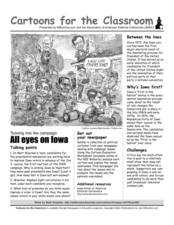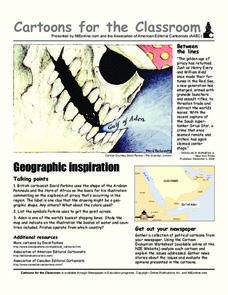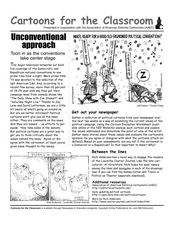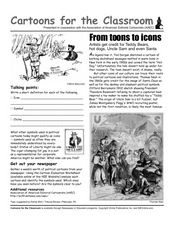National First Ladies' Library
All the News That's Fit to Draw: Political Cartooning and the Presidency
Students research, analyze and study the history of political cartooning in the United States. They recognize a political cartoon, be able to identify the main idea, the symbols and the exaggeration and caricature in political cartoons....
Curated OER
Cartoons for the Classroom: All Eyes on the Iowa Caucus
Explore the primary elections through political cartoons. Three talking points guide deeper thinking as pupils analyze a cartoon, which depicts the 2008 campaigning in Iowa. Analysts identify caricatures, research why winning Iowa is...
Curated OER
Cartoons for the Classroom: Great Expectations
Learners can use this worksheet to discuss the expectations placed on the Obama presidency. Included are two cartoons to analyze, a web site to visit, several great discussion questions, and a short activity. This is one worksheet that...
Curated OER
Cartoons for the Classroom: The Bush and Clinton Years
Examine how the Bush and Clinton years are an example of political dynasties. This cartoon provides a way to explore the concept and activate critical thinking skills in order to better grasp U.S. Politics. A fun and educational way to...
Curated OER
Cartoons for the Classroom: Celebrating the 19th Amendment
Eighty-eight years after women earned the right to vote, a women ran for president. Young analysts consider the role women play in politics, how they are portrayed, the standards they are held to, and if they are still treated unfairly...
Curated OER
Cartoons for the Classroom: Geographic Inspiration
A wonderfully graphic cartoon entices learners to read more about issues near the Arabian Peninsula. They will use the provided cartoon and critical thinking question to practice building their analytical and critical thinking skills....
Curated OER
Cartoons for the Classroom: A Parody of Broken Promises
Parodies of political figures are the lifeblood of the editorial cartoons in a free press. North Korea's nuclear threat provides young political scientists an opportunity to hone their critical thinking skills as they analyze a...
Curated OER
Cartoons for the Classroom: 9/11 Revisited
Political cartoons about the September 11 terrorist attacks provide an opportunity for class members to analyze the inferences embedded in the drawings.
Curated OER
Cartoons in the Classroom: Constitutional Amendments
Upper graders use this instructional activity to hone their analysis skills and gain a deeper understanding of various constitutional amendments. There are two cartoons to analyze, background information, additional resource links, and...
Curated OER
Analyzing Political Cartoons
Seventh graders identify a political cartoon and analyze a pre-Revolutionary War political cartoon. In this political cartoon lesson, 7th graders discuss cartoons and the historical beginnings of American politics using a PowerPoint...
Curated OER
Learning to Analyze Political Cartoons with Lincoln as a Case Study
Eighth graders examine the attributes of political cartoons. In this American Civil War lesson plan, 8th graders analyze a cartoon titled " The Good Uncle and the Naughty Boy." Students then create their own political cartoons about...
Curated OER
Cartoons for the Classroom: Unconventional Approach
In this current events activity, students analyze political cartoons that feature campaign information. Students collect political cartoons from their own newspapers and respond to discussion questions.
Curated OER
Cartoons for the Classroom: Oh, Canada
For this current events worksheet, students analyze political cartoons about the prorogue in Canada and respond to 3 talking point questions.
Curated OER
Cartoons for the Classroom: Learning to Interpret a Convention
In this current events worksheet, students analyze political cartoons about political conventions. Students respond to 4 talking point questions.
Curated OER
Cartoons for the Classroom: Tooning into the Olympics
In this current events worksheet, students analyze political cartoons about the commercialism of the modern Olympics. Students then respond to 3 short answer questions.
Curated OER
Cartoons for the Classroom: Taking a Stand
In this current events worksheet, students analyze political cartoons that feature the use of persuasion and propaganda. Students respond to 2 short answer questions.
Curated OER
Cartoons for the Classroom: From Toons to Icons
In this current events worksheet, students analyze political cartoons that feature icons like the hot dog and the teddy bear. Students respond to 3 talking point questions.
Curated OER
Cartoons for the Classroom: Keep Current Through a Cartoonist's Commentary
In this current events worksheet, students analyze political cartoons about the Middle East and American domestic issues. Students respond to 4 talking point questions.
Curated OER
Cartoons for the Classroom: Welcoming the New Congress in Cartoons
In this current events worksheet, students analyze political cartoons about the 110th Congress. Students respond to 3 talking point questions.
Curated OER
Cartoons for the Classroom: Donkeys, Elephants, and Elections
In this current events worksheet, students analyze political cartoons about the 2006 American mid-term elections. Students then respond to 3 short answer questions.
Curated OER
Cartoons for the Classroom: Tooning into the Cosmos
In this current events activity, students analyze political cartoons that feature space science. Students respond to 3 talking point questions.
Curated OER
Cartoons in the Classroom: Visual Clichés
In this current events worksheet, learners analyze political cartoons featuring the use of clichés. Students respond to 2 talking point questions.
Curated OER
Cartoons for the Classroom: Toons as Tributes
In this current events worksheet, learners analyze political cartoons that feature tributes to Pope John Paul II. Students respond to 3 talking point questions.
Curated OER
Cartoons for the Classroom: The Competition of Ideas
In this current events worksheet, learners analyze political cartoons based on anti-American sentiments. Students respond to 4 talking point questions

























